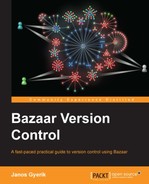- Bazaar Version Control
- Table of Contents
- Bazaar Version Control
- Credits
- About the Author
- About the Reviewers
- www.PacktPub.com
- Preface
- 1. Getting Started
- 2. Diving into Bazaar
- Understanding the core concepts
- Introducing the user interfaces
- Configuring Bazaar
- Performing the basic version control operations
- Putting a directory under version control
- Checking the status of files and directories
- Adding files to version control
- Recording a new revision
- Ignoring files
- Deleting files
- Undoing changes
- Editing files
- Viewing differences in changed files
- Renaming or moving files
- Viewing the revision history
- Restoring files from a past revision
- Putting it all together
- Beyond the basics
- Summary
- 3. Using Branches
- What is a branch?
- What can you do with branches?
- Why use more than one branch?
- Understanding core terms and concepts
- Using a shared repository
- Basic branching and merging
- Using the branch command
- Viewing basic branch information
- Comparing branches
- Merging branches
- Mirroring branches
- Summary
- 4. Using Bazaar in a Small Team
- Collaborating with others
- Sharing branches over the network
- Working with remote branches
- Implementing simple workflows
- Summary
- 5. Working with Bazaar in Centralized Mode
- 6. Working with Bazaar in Distributed Mode
- The distributed mode in general
- The human gatekeeper workflow
- The automatic gatekeeper workflow
- The shared mainline workflow
- Choosing a distributed workflow
- Summary
- 7. Integrating Bazaar in CDE
- What is a CDE?
- Working with Launchpad
- Integrating Bazaar into Redmine
- Integrating Bazaar into Trac
- Linking commits to bug trackers
- Web-based repository browsing with Loggerhead
- Summary
- 8. Using the Advanced Features of Bazaar
- 9. Using Bazaar Together with Other VCS
- Working with other VCS in general
- Using Bazaar with Subversion
- Installing bzr-svn
- Supported protocols and URL schemes
- Using the example Subversion repository
- Understanding branches in Subversion
- Branching or checkout from Subversion
- Preserving Subversion metadata
- Pulling or updating from Subversion
- Committing to Subversion
- Pushing to Subversion
- Merging Subversion branches
- Merging local branches into Subversion
- Binding and unbinding to Subversion locations
- Using lightweight checkouts
- Browsing the logs
- Limitations of bzr-svn
- Final remarks on bzr-svn
- Using Bazaar with Git
- Migrating between version control systems
- Summary
- 10. Programming Bazaar
- Using Bazaar programmatically
- Creating a plugin
- Using the example plugins
- Naming the plugin
- Creating the plugin directory
- Implementing the plugin
- Writing the README file
- Creating __init__.py
- Writing unit tests
- Creating setup.py
- Browsing existing plugins
- Registering your plugin
- Creating a hook
- References
- Summary
- Index
Branch operations work consistently, regardless of whether you use the centralized mode or not.
Although the centralized mode permits multiple collaborators committing unrelated changes continuously in the central branch, it is better to work on new improvements in dedicated feature branches and merge them into the central branch only when they are ready. In this way, the revision history remains easy to read, and if a feature causes problems, then all the revisions involved in it can be reverted easily with one swift move.
Even in a centralized workflow, you are free to use as many local private branches as needed. You can slice and dice your local branches and when a feature is ready, you can merge them into the central branch, and all the intermediate revisions will be preserved in the history.
Team members can work on a feature branch together by sharing the branch on the central server. One of the team members can start working on the feature, and at some point push the branch on the server so that others can checkout from it and start contributing their work. After pushing the branch to the server, the original contributor can switch to the centralized mode using the bind command.
-
No Comment
